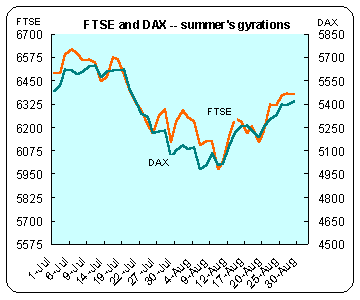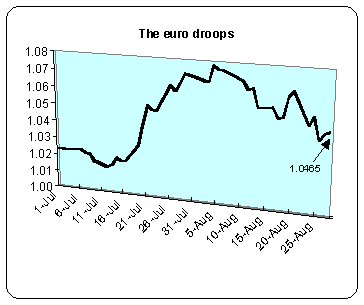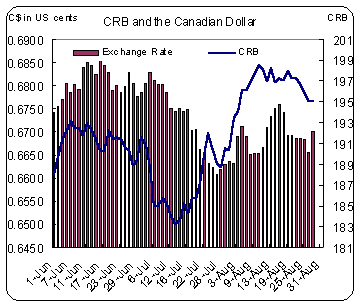|
International Perspectives - August 30, 1999
Anne D. Picker
International Economist, Econoday
Interest Rate Angst
The Federal Reserve obliged the markets and finally raised their federal funds rate 25 basis points to 5.25 percent on Tuesday. Everyone was relieved until Friday, when Alan Greenspan spoke at a Kansas City Federal Reserve Bank meeting in Jackson Hole, Wyoming along with several other central bankers. What Mr Greenspan was interpreted as saying along with very thin end of summer volume combined to have a negative effect on most markets.
Central Bank Update
The European Central Bank returned from vacation and met on Thursday. Germany's Bundesbank issued its monthly report on Euroland's economic performance.
The European Central Bank's Governing Council did not change its official interest rates at its meeting on Thursday. The main refinancing rate remains at 2.5 percent.
Another goal of the European Monetary Union along with controlling inflation, is budgetary discipline. The proportion of debt to gross national product has fallen for member countries. However, the decline is not because of the fiscal reforms that are needed in taxation and welfare, for example. Rather the drop primarily reflects lower interest rates on outstanding debt.
The news from euroland continues to be upbeat. However, the recovery is unlikely to translate into a substantial fall in unemployment anytime soon even though the expansion is creating new jobs. The current unemployment rate is 10.3 percent, over double the U.S. rate of 4.3 percent.
The markets are concerned about the potential for an interest rate increase by the ECB already, even though inflation is muted and unemployment is remains high.

The Bundesbank, in its monthly report for August said that euroland economic activity has continued to expand into the second quarter. The Bank pointed in particular, to the noticeable improvement in industrial confidence, which is due largely to a better export and production outlook. But the report said that the improved business confidence has not yet translated into rising industrial output. The Bundesbank also noted that there continues to be considerable divergence among growth rates within the European Union, with the smaller countries generally growing faster than the larger ones, especially Italy and Germany.
An Indicator Potpourri
Europe
United Kingdom - The Confederation of British Industry (CBI) raised its 1999 GDP forecast to 1.2 percent from its earlier forecast of 0.8 percent on stronger than expected consumer spending. The CBI expects the Bank of England's main interest rate (now at five percent) to remain unchanged until end of 2000, although there could be scope for a small cut if sterling increases in value and inflation stays low. The CBI noted that while manufacturers expect domestic demand to improve, overall demand was still weak and prices continued to fall. CBI's August Industrial Trends Survey showed increased optimism. However, despite the good survey showing, it noted that demand was still relatively weak and prices were still falling.
Revised second-quarter gross domestic product remained at +0.5 percent on the quarter and +1.2 percent on the year. The expenditure side showed underlying strength with most components (households, etc) positive contributors with the exception of inventories. This implies that British industry is nearing the end of inventory liquidation. This should pave the way for sharp growth the second half of the year as inventories are replenished.
June's global trade deficit was worse than expected. The July non-EU trade deficit also rose. While the global trade deficit trend continues to widen, the deterioration is slowing and beginning to level out. The strong currency (sterling) has hurt exporters hard and was exacerbated by slow growth in Europe and no growth in Asia. With these economies turning around, an improvement in exports should be close at hand.
Germany - The Ifo's monthly report said that sentiment has improved even though current business conditions remained negative. More businesses are optimistic about the next six months because they anticipate strong exports. Both the business climate and the business expectations indexes rose. The business expectations index tends to be a good indication of future output.
Several price indices were released last week. Producer prices in the 6 months to July rose at a seasonally adjusted annualized 1.8 percent, after a 0.2 percent fall in June. This came after a jump in the July 6-month consumer price index rate to 1.7 percent from 0.6 percent in June. The increases were largely due to higher oil prices. July import prices rose a stronger than expected 0.9 percent on the month, due almost entirely to higher oil prices.
France - A net of 47,300 non-farm jobs were created in the French private sector during the second quarter. This is a 0.3 percent increase on the quarter and 1.9 percent on the year. Final July CPI data confirmed the decline of 0.2 percent on the month and the preliminary estimates in all major categories. Falling manufacturing goods prices (-1.4 %) and food prices (-0.7 %) offset the 2.3 percent jump in oil prices.
Asia
Japan - The August consumer price index rose 0.3 percent and 0.3 percent when compared to August of 1998. It was in line with expectations. Spending by families of salaried workers in Japan rose an inflation-adjusted 2.6 percent in July on a year earlier. But income for wage earners was down an annualized 4.0 percent.
Japan's trade surplus was wider than expected in July although it declined 4.6 percent on the year. Exports fell 7.6 percent while imports fell 8.8 percent, both when compared with last year. However, the trade surplus with the United States rose eight percent on the year.
Hong Kong - Second quarter GDP rose 0.5 percent when compared with a year ago. In contrast, GDP declined 3.4 percent in the first quarter. It is too early to say that the economy has turned around.
South Korea - South Korea posted its biggest current account surplus of the year as the stronger yen and recovery across Asia meant more exports. The increase in exports along with an influx of foreign investment produced the surplus.
The indicators continue to tell us that the Asian and European economies are crawling their way out of the no growth/slow growth scenarios of the past several years. However, they are by no means out of the woods yet. Structural problems have not been addressed to the extent necessary in both Asia and Europe to assure steady long term growth.
Financial Markets
World Stock Exchanges
The markets continued to focus their attention on the United States and the Federal Reserve Open Market Committee meeting last week. With the interest rate increase behind them, market players should move on to more domestic concerns. Instead they seem ready to focus in on the next FOMC meeting in October - a long way away in market speak.
Europe
The FTSE, the CAC and DAX closed on the up side for the week. Investors are looking for guidance to the mass of economic data that will be released this week. They are looking for clues on whether interest rates will rise in the fourth quarter on either side of the Atlantic. The main release on this side of the Atlantic is the U.S. employment situation report on Friday. Europe's main release in is on Wednesday. A series of purchasing managers surveys will be scrutinized to see if the European Central Bank will raise rates before year's end. Trading volumes remained pathetically thin last week as traders took the last of their summer vacation. London markets are closed on Monday, which marks the end of the summer season in Europe and a return to business as usual.

Asia
The Nikkei staggered last week and sank 2.76 percent. The markets were pessimistic about the banking sector. Investors are concerned that the industry continues to be mired in bad loans at a time when the economy may not be expanding quickly enough to improve banking earnings. The market seemed to be having second thoughts about the merger between Industrial Bank of Japan Ltd., Fuji Bank Ltd., and Dai-Ichi Kangyo Bank Ltd. into the largest bank in the world.
The Hong Kong Heng Seng index slipped 1.35 percent as investors anticipated an interest rate increase following last week's 25 basis point rise by the Federal Reserve. After the market close, the Hong Kong Association of Banks obliged and raised its short term savings rate to 3.75 percent prompting member banks to pass on the 25 basis point increase. This was the first rate increase since January 1998.
| Selected World Stock Market Indexes |
| Index | 27-Aug | 1999
High | 1999
Low | Week %
Change |
|---|
| Asia |
| Australia | All Ordinaries | 3020.20 | 3145.20 | 2804.80 | -0.17 |
| Japan | Nikkei 225 | 17599.37 | 18357.90 | 13232.70 | -2.76 |
| Hong Kong | Hang Seng | 13383.13 | 14506.74 | 9076.33 | -1.35 |
| S. Korea | Korea Composite | 960.28 | 1027.93 | 498.42 | 9.32 |
| Europe |
| Britain | FTSE 100 | 6375.20 | 6420.60 | 5770.20 | 3.15 |
| France | CAC |
4642.71 | 4697.80 | 3958.70 | 3.82 |
| Germany | XETRA DAX | 5420.36 | 5652.00 | 4668.50 | 3.16 |
| North America |
| United States | Dow | 11090.17 | 11209.80 | 9120.70 | -0.09 |
| Canada | TSE Composite 300 | 7106.20 | 7292.70 | 6180.30 | -0.32 |
| Mexico | Bolsa | 5252.33 | 7292.70 | 6180.30 | 3.00 |
Currencies
Yen
With the threat of intervention by Japanese monetary authorities hanging over its head, the yen/U.S. dollar relationship traded within a tight range last week. (As the yen appreciates, there are fewer yen per dollar). Market players were reluctant to test the 110 yen to the dollar mark. This is where the exchange rate really begins to hurt exporters. Traders in Tokyo speculated that the strong yen would be a topic of discussion at a Group of Seven (United States, Canada, United Kingdom, Germany, France, Italy and Japan) meeting scheduled for later this week in Berlin. However, analysts say that the meeting probably represents nothing more than preparation for the G7 meeting that is held at the same time as the semi annual International Monetary Fund meeting in September in Washington.

Euro
The euro closed lower last week versus the dollar and near to its historic lows against the yen. Although the euro is struggling, down significantly for the week, it is notable that it is not weak versus other European currencies such as the Swiss franc and Norwegian krona, and held steady with sterling. Analysts think that it is not the euro itself that is suspect, but rather the dollar and yen just had a better week. The economic news suggests moderating growth in the second quarter when compared to the first, but business momentum building for a strong second half of the year.

Canadian dollar
Foreign and domestic speculators continued to sell the Canadian dollar during the first four days of last week, taking the currency down to 66.59 U.S. cents before rebounding on Friday to 67.17 U.S. cents in early morning trading. Divergent interest rate policies between Canada and the United States, along with floundering commodity prices painted a negative backdrop for Canada, despite its good economic performance. Below is a graph that shows the relationship between commodity prices and the Canadian dollar.

Why U.S. investors care
Investors will be watching the avalanche of U.S. economic indicators this week to monitor the strength of the U.S. economy and their impact on monetary policy. Similarly, those in the international investment community will be focusing on the strength of the European recovery now that summer vacation season is over. With growth beginning to accelerate, Europe will provide a market for U.S. exporters, which will help our ballooning trade deficit. It will also take pressure off the United States to be the growth engine to the world. And there will be new investment opportunities for U.S. investors, as international growth becomes a reality.
Looking Ahead
The following indicators will be released this week.
| Europe | | |
| August 30 | Italy | Retail Sales (June) |
| August 31 | Italy | Producers Price Index (July) |
| France | Unemployment (July) |
| | Industrial Production (June) |
| EU | Trade Balance (June) |
| September 1 | EU | Reuters PMI (August) |
| UK | PMI manufacturing survey (August) |
| September 2 | EU | Balance of Payments (Q2,99) |
| September 3 | Germany | Wholesale Sales (July) |
| EU | Unemployment (July) |
| Italy | Non EU Trade Balance (July) |
| | EU Trade Balance (June) |
| Asia | | |
| August 31 | Japan | Labor Market (July) |
| | Industrial Production (July) |
| North America | | |
| August 31 | Canada | Gross Domestic Product (Q2, 99) |
| | Balance of Payments (Q2,99) |
| | Gross Domestic Product at Factor Cost (June) |
Sometime during
the week | G-7 Deputy Finance Ministers meet in Berlin |
Release dates are subject to change.
For U.S. data releases, see this week's Simply Economics.
|






